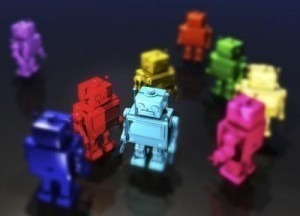For a long time, robots were the preserve of science fiction. We’ve always been fascinated by the idea of intelligent machines, whether it was the development of Asimov’s three laws of robotics, the bickering Star Wars droids, or Douglas Adam’s manically depressed Marvin. Yet, the impact of robots on day-to-day life has been slow to emerge. Few of us have the android domestic staff that was the stuff of 1950’s visions of the future, for example, but, in fact, robots are in more areas of our existence than you might think.
Industrial Robots
The first robotic patents for machines to be used in industry were granted in 1961, so they have a longer history than you might think. These were mainly for simple transfer systems that moved components from one place to another to aid assembly processes.
Because they were able to repeat tasks over and over again to the same level of accuracy, robots quickly found their place on the production line. This was something that came to public consciousness with the Fiat car adverts of the late 1970s. By this time, robots were undertaking other repetitive tasks such as welding and paint spraying.
The industrial use of robots has now reached a high level of maturity. The latest robots are typically linked to a computer, making it easier to reprogram them to perform different tasks and adapt to changes in the products being built.
If you’re interested in finding out more about robots in manufacturing, it’s worth visiting the http://www.learnaboutrobots.com/industrial.htm website.
Harsh Environments
Of course, robots are useful for work in harsh environments where it’s difficult or dangerous for humans to operate. Nuclear power stations are a good example, but robots are also used for underwater tasks like salvage or carrying out maintenance on oil platforms. They have a long history of use in bomb disposal too.
The same qualities that make robots good for these tasks also make them useful for exploration. Again, the underwater world comes to mind, although robots are also used in space exploration, from the robot arm on the Space Shuttle to the rovers used on missions to the moon and Mars.
Educational Robots
In addition to their uses in industry, robots have also become a useful educational tool. Arduino is a good example. The arduino kits are available online via the big electrical components wholesalers like RS and Premier Farnell. For example, robotics kits like Arduino products from RS can be used to teach basic electronics and programming in a way that’s practical, but also engaging and fun for the students.
There are regular competitions to design robots for various tasks. Playing football is one such example; there’s even a RoboCup. This encourages schools and colleges to become involved in robotics and ensures that we have a future generation of designers.
It’s easy to think of robots as still belonging to the future. However, they already play a key part in many facets of our everyday world. From building the consumer products that we take for granted to helping us learn more about the environment around us, robots are at the forefront.
